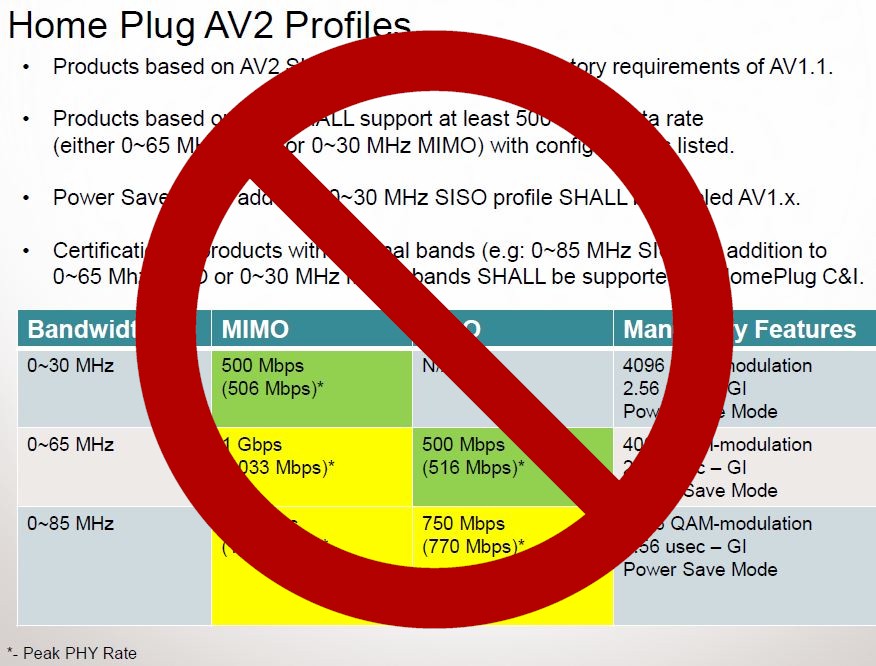I’ve often referred to the Home Plug AV2 profile graphic below in our powerline adapter reviews and used it as the basis of SmallNetBuilder’s Powerline device classification system. Turns out, neither the chipmakers nor powerline product makers use it.
I had an illuminating discussion yesterday with Dr. Stephen Palm. He’s a Senior Technical Director at Broadcom and also serves as Vice President and Board of Director member of the HomePlug Alliance. Dr. Palm said the AV2 profiles were created early in the development of the AV2 standard. But it’s not a binding standard and basically "no one follows it".

HomePlug AV2 Profiles: Fiction
My takeaway from our discussion as that each AV2 chipmaker (there are currently only Broadcom and Qualcomm Atheros) uses its own secret sauce of bandwidth and modulation techniques so that product makers can play the old game of slap-the-biggest-number-on-the-box.
For example, here’s the calculation behind the 1000 Mbps "speed" claimed for ZyXEL’s PLA5206, a “1000 Mbps” adapter based on Broadcom’s BCM60333 AV2-SISO chip.
- The BCM60333 can use a bandwidth of up to 84.3 MHz (from ~1.8 MHz up to ~86.1 MHz).
- In this bandwidth, a total of 3455 OFDM carriers are employed with a minimum symbol time of 40.96 us
- The maximum bit allocation per carrier is 12
- The maximum PHY rate is obtained as follows: 3455 carriers x 12 bits/carrier ÷ 40.96us = 1012.2 Mbps
For adapters based on Broadcom’s BCM60500 AV2-MIMO chip such as D-Link’s DHP-701AV, a 2X multiplier gets thrown in there somewhere to yield the "2000 Mbps" rating you see on the D-Link’s box.
I don’t have QCA’s calculation handy, but it’s apparently way more conservative, with products claiming only 600 Mbps for AV2-SISO products and 1200 Mbps for AV2-MIMO.
Dr. Palm said the HomePlug Alliance has different Certification suites for AV and AV2 products, but doesn’t differentiate between SISO and MIMO products in the AV2 certification suite. The suite focuses primarily on four key areas:
- Interoperability
- Throughput
- Power Save
- Pushbutton Security
We didn’t get into the specifics behind each area, but it’s interesting there aren’t different minimum throughput requirements to Certify AV2-SISO and AV2-MIMO.
SmallNetBuilder’s New Powerline Product Classes
So since the AV2 Profile chart is fiction, we’re simplifying our classification system. The new classes are in Table 1.
| Advertised Link Rates | Devices | |
|---|---|---|
| AV | 200 Mbps | – INT6400 / INT1400 – QCA6410 – BCM 60321 |
| AV500 | 500 Mbps | – QCA AR7420 / AR1540 – AR7400 / AR1500 |
| AV2-SISO | 600 Mbps | – QCA7450 / AR1540 |
| 1000 Mbps | – BCM60333 | |
| AV2-MIMO | 1200 Mbps | – QCA7500 |
| 2000 Mbps | – BCM60500 |
Table 1: Powerline product classes
Although the HomePlug Alliance says it doesn’t treat AV2 SISO and MIMO devices differently, we’ll continue to class and rank them separately.
All products have been reclassed and reranked as needed to reflect this new system. We hope it helps reduce the confusion powerline product marketeers have created in the effort to win your wallets.
